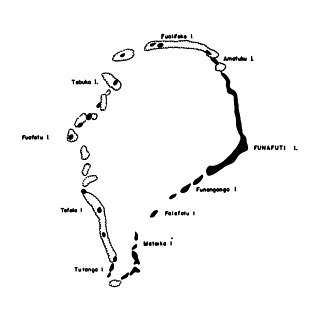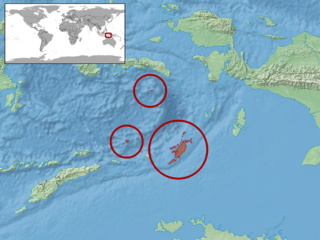
Gekkonidae is the largest family of geckos, containing over 950 described species in 64 genera. Members of the Gekkonidae comprise many of the most widespread gecko species, including house geckos (Hemidactylus), tokay geckos (Gekko), day geckos (Phelsuma), mourning geckos (Lepidodactylus) and dtellas (Gehyra). Gekkonid geckos occur globally and are particularly species-rich in tropical areas.

Lepidodactylus is a large genus of geckos, commonly known as scaly-toed geckos and closely related to house geckos or dtellas.

Tepuka is an island eighteen kilometers west of Fongafale, in the northwest of Funafuti, the main atoll of the Oceanian nation of Tuvalu. Te puka, or Pouka, is the name of a tree - Hernandia peltata.

Lepidodactylus listeri, also known commonly as Lister's gecko or the Christmas Island chained gecko, is a species of gecko, a lizard in the family Gekkonidae, endemic to Christmas Island in the Indian Ocean. It is currently extinct in the wild.
Fuagea is an islet located in the archipelago of Tuvalu in the south-western part of the atoll of Funafuti.

Lepidodactylus lugubris, known as the mourning gecko or common smooth-scaled gecko, is a species of lizard, a gecko of the family Gekkonidae.
The Seventy Islands gecko is a lizard endemic to Palau.

Lepidodactylus aureolineatus, also known as the golden scaly-toed gecko or yellow-lined smooth-scaled gecko, is a species of gecko. It is endemic to the Philippines.

The Batan scaly-toed gecko is a species of gecko. It is endemic to the Philippines.
Brown's scaly-toed gecko is a species of lizard in the family Gekkonidae. The species is endemic to Papua New Guinea.
Lepidodactylus euaensis, also known as the Eua scaly-toed gecko or Eua forest gecko, is a species of gecko. It is endemic to ʻEua Island in Tonga.
Lepidodactylus flaviocularis, also known as the yellow-eyed scaly-toed gecko or yellow-eyed gecko, is a species of gecko. It is endemic to Guadalcanal in the Solomon Islands.
Lepidodactylus guppyi, also known commonly as the Solomons scaly-toed gecko or Guppy's gecko, is a species of gecko, a lizard in the family Gekkonidae. The species is endemic to islands in the southwestern Pacific Ocean.

Lepidodactylus herrei, known commonly as the Negros scaly-toed gecko or the white-lined smooth-scaled gecko, is a species of gecko, a lizard in the family Gekkonidae. The species is endemic to the Philippines.
The mountain scaly-toed gecko is a species of gecko. It is endemic to Papua New Guinea.
Lepidodactylus manni, also known commonly as the Fiji scaly-toed gecko or the Viti forest gecko, is a species of gecko, a lizard in the family Gekkonidae. The species is endemic to Fiji.
Lepidodactylus moestus is a species of gecko. It is found in the Marshall Islands, Federated States of Micronesia, and Palau.

Lepidodactylus oortii is a species of gecko, a lizard in the family Gekkonidae. The species is endemic to Indonesia.
Lepidodactylus pulcher, also known as the Wild scaly-toed gecko or Admiralty gecko, is a species of gecko. It is endemic to the Admiralty Islands.

Lepidodactylus labialis, also known as the Mindanao false gecko or dark-spotted smooth-scaled gecko, is a species of gecko. It is endemic to the Philippines. It is sometimes placed in the genus Pseudogekko.









